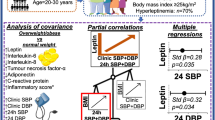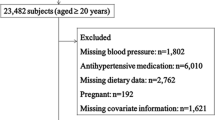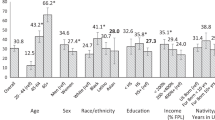Abstract
Increased plasma volume is often reported as a cause or symptom of hypertension in individuals with obesity. However, these individuals are often compared to normal weight normotensive individuals. Since higher plasma volumes have been reported in larger individuals, it is possible that plasma volume is actually lower in obese hypertensive individuals compared to normotensive obese individuals. This may be important for better understanding the clinical manifestation of hypertension between weight categories. National Health and Nutritional Examination Survey (cycles 1999–2018) data were used to examine the relationship between plasma (derived from the Straus formula), blood pressure (measured with an automated device) and body mass index. We observed an inverse relationship between estimated plasma volume and systolic (B = −1.68 (95% CI: −2.06, −1.30) mmHg), p < 0.0001), diastolic (B = −3.35 (95% CI: −3.61, −3.08) mmHg) p < 0.0001), and mean arterial pressure (B = −2.79 (95% CI: −3.05, −2.53) mmHg) p < 0.0001). The relationship between estimated plasma volume and diastolic blood pressure (interaction term: B = −0.069 (−0.10, −0.03), p < 0.0001) did depend on BMI. The “normal weight” group had the lowest slope and this slope was significantly different from the “obese” (B = −1.47 (95% CI: −1.88, −1.07)) and “overweight” (B = −1.11 (−1.55, −0.67)) groups. Plasma volume is lower in hypertensive individuals regardless of weight status, but this relationship is more pronounced among obese individuals.
This is a preview of subscription content, access via your institution
Access options
Subscribe to this journal
Receive 12 digital issues and online access to articles
$119.00 per year
only $9.92 per issue
Buy this article
- Purchase on Springer Link
- Instant access to full article PDF
Prices may be subject to local taxes which are calculated during checkout


Similar content being viewed by others
Data availability
The data used for this analysis can be found on the NHANES website https://www.cdc.gov/nchs/nhanes/index.htm.
References
Danaei G, Ding EL, Mozaffarian D, Taylor B, Rehm J, Murray CJ, et al. The preventable causes of death in the United States: comparative risk assessment of dietary, lifestyle, and metabolic risk factors. PLoS Med. 2009;6:e1000058.
Tarazi RC, Dustan HP, Frohlich ED, Gifford RW Jr., Hoffman GC. Plasma volume and chronic hypertension. Relationship to arterial pressure levels in different hypertensive diseases. Arch Intern Med. 1970;125:835–42.
Tarazi RC, Frohlich ED, Dustan HP. Plasma volume in men with essential hypertension. N Engl J Med. 1968;278:762–5.
Chau NP, Safar ME, Weiss YA, London GM, Simon AC, Milliez PL. Relationships between cardiac output, heart rate and blood volume in essential hypertension. Clin Sci Mol Med. 1978;54:175–80.
Blaustein MP, Zhang J, Chen L, Hamilton BP. How does salt retention raise blood pressure? Am J Physiol Regul Integr Comp Physiol. 2006;290:R514–23.
Hall JE. Guyton and hall textbook of medical physiology. 14. ed. Philadelphia: Elsevier; 2020. pages cm p.
Julius S. Changing role of the autonomic nervous system in human hypertension. J Hypertens Suppl. 1990;8:S59–65.
Hall JE, Mizelle HL, Hildebrandt DA, Brands MW. Abnormal pressure natriuresis. A cause or a consequence of hypertension? Hypertension. 1990;15:547–59.
Messerli FH, Christie B, DeCarvalho JG, Aristimuno GG, Suarez DH, Dreslinski GR, et al. Obesity and essential hypertension. Hemodynamics, intravascular volume, sodium excretion, and plasma renin activity. Arch Intern Med. 1981;141:81–5.
Diaz ME. Hypertension and obesity. J Hum Hypertens. 2002;16:S18–22.
Messerli FH, Ventura HO, Reisin E, Dreslinski GR, Dunn FG, MacPhee AA, et al. Borderline hypertension and obesity: two prehypertensive states with elevated cardiac output. Circulation. 1982;66:55–60.
Ulrych M, Frohlich ED, Tarazi RC, Dustan HP, Page IH. Cardiac output and distribution of blood volume in central and peripheral circulations in hypertensive and normotensive man. Br heart J. 1969;31:570.
Frohlich ED, Tarazi RC, Dustan HP. Re-examination of the hemodynamics of hypertension. Am J Med Sci. 1969;257:9–23.
Whelton PK, Carey RM, Aronow WS, Casey DE Jr., Collins KJ, Dennison Himmelfarb C, et al. 2017 ACC/AHA/AAPA/ABC/ACPM/AGS/APhA/ASH/ASPC/NMA/PCNA Guideline for the Prevention, Detection, Evaluation, and Management of High Blood Pressure in Adults: A Report of the American College of Cardiology/American Heart Association Task Force on Clinical Practice Guidelines. Hypertension. 2018;71:e13–e115.
Atkinson G, Batterham AM. True and false interindividual differences in the physiological response to an intervention. Exp Physiol. 2015;100:577–88.
Johnson CL, Paulose-Ram R, Ogden CL, Carroll MD, Kruszon-Moran D, Dohrmann SM, et al. National health and nutrition examination survey: analytic guidelines, 1999-2010. Vital- Health Stat. 2013;2:1–24.
Duarte K, Monnez JM, Albuisson E, Pitt B, Zannad F, Rossignol P. Prognostic value of estimated plasma volume in heart failure. JACC Heart Fail. 2015;3:886–93.
Ostchega Y, Hughes JP, Terry A, Fakhouri TH, Miller I. Abdominal obesity, body mass index, and hypertension in US adults: NHANES 2007-2010. Am J Hypertens. 2012;25:1271–8.
Schmieder RE, Messerli FH, Garavaglia GE, Nunez BD. Dietary salt intake. A determinant of cardiac involvement in essential hypertension. Circulation. 1988;78:951–6.
Zhang Z, Cogswell ME, Gillespie C, Fang J, Loustalot F, Dai S, et al. Association between usual sodium and potassium intake and blood pressure and hypertension among U.S. adults: NHANES 2005-2010. PLoS One. 2013;8:e75289.
Gibson JG, Evans WA. Clinical studies of the blood volume. Ii. The relation of plasma and total blood volume to venous pressure, blood velocity rate, physical measurements, age and sex in ninety normal humans. J Clin Invest. 1937;16:317–28.
Franklin SS, Gustin WT, Wong ND, Larson MG, Weber MA, Kannel WB, et al. Hemodynamic patterns of age-related changes in blood pressure. The Framingham Heart Study. Circulation. 1997;96:308–15.
Oparil S, Wright JT Jr. Ethnicity and blood pressure. J Clin Hypertens. 2005;7:357–64.
Chrysant SG, Danisa K, Kem DC, Dillard BL, Smith WJ, Frohlich ED. Racial differences in pressure, volume and renin interrelationships in essential hypertension. Hypertension. 1979;1:136–41.
Levey AS, Stevens LA, Schmid CH, Zhang YL, Castro AF 3rd, Feldman HI, et al. A new equation to estimate glomerular filtration rate. Ann Intern Med. 2009;150:604–12.
Julius S, Pascual AV, Reilly K, London R. Abnormalities of plasma volume in borderline hypertension. Arch Intern Med. 1971;127:116–9.
Kotsis V, Stabouli S, Papakatsika S, Rizos Z, Parati G. Mechanisms of obesity-induced hypertension. Hypertens Res. 2010;33:386–93.
Tanaka M. Improving obesity and blood pressure. Hypertens Res. 2020;43:79–89.
Messerli FH, De Carvalho JG, Christie B, Frohlich ED. Systemic and regional hemodynamics in low, normal and high cardiac output borderline hypertension. Circulation. 1978;58:441–8.
Granger JP, Alexander BT, Llinas M. Mechanisms of pressure natriuresis. Curr Hypertens Rep. 2002;4:152–9.
Mujais SK, Tarazi RC, Dustan HP, Fouad FM, Bravo EL. Hypertension in obese patients: hemodynamic and volume studies. Hypertension. 1982;4:84–92.
Shibao C, Gamboa A, Diedrich A, Ertl AC, Chen KY, Byrne DW, et al. Autonomic contribution to blood pressure and metabolism in obesity. Hypertension. 2007;49:27–33.
Marawan A, Qayyum R. Estimated plasma volume and mortality: analysis from NHANES 1999-2014. Clin Res Cardiol. 2020;109:1148–54.
Fudim M, Miller WL. Calculated estimates of plasma volume in patients with chronic heart failure-comparison with measured volumes. J Card Fail. 2018;24:553–60.
Kobayashi M, Huttin O, Donal E, Duarte K, Hubert A, Le Breton H, et al. Association of estimated plasma volume status with hemodynamic and echocardiographic parameters. Clin Res Cardiol. 2020;109:1060–9.
Author information
Authors and Affiliations
Contributions
RWS, PDL, and JPL conceived of the idea. PDL performed the statistical analysis. RWS wrote the paper. RWS, PDL, and JPL edited and approved the final manuscript.
Corresponding author
Ethics declarations
Competing interests
The authors declare no competing interests.
Additional information
Publisher’s note Springer Nature remains neutral with regard to jurisdictional claims in published maps and institutional affiliations.
Rights and permissions
About this article
Cite this article
Spitz, R.W., Loprinzi, P.D. & Loenneke, J.P. Individuals with hypertension have lower plasma volume regardless of weight status. J Hum Hypertens 37, 491–495 (2023). https://doi.org/10.1038/s41371-022-00705-w
Received:
Revised:
Accepted:
Published:
Issue Date:
DOI: https://doi.org/10.1038/s41371-022-00705-w



